
Four top-tier toggers share their insights on one of the hottest fisheries this fall.
Now that we are in the middle of blackfish season for the Jersey shore, Long Island and the New England coast, what’s better than getting some salient tog tips from the folks who do this for a living?
For this month’s piece, I had in-depth chats with Capt. Jason Colby of Little Sister Charters based out of Westport, MA; Capt. Kerry Doughton of JB Charters sailing from Waterford, CT; Capt. Tim Daffin from Fishin’ Fever charters in Capt May, NJ; and Capt. Phil Kess of Fishy Business charters based in Orient, NY. All four of these tog pros make 50 to 100 dedicated trips each season for this popular coastal quarry, sailing in a variety of weather and sea conditions, so they know the inner secrets that many of us want to learn.
Let’s take a guided tour to their favorite piece of bottom structure and see how they get things done.
Capt. Jason Colby, Little Sister Charters, Westport, MA
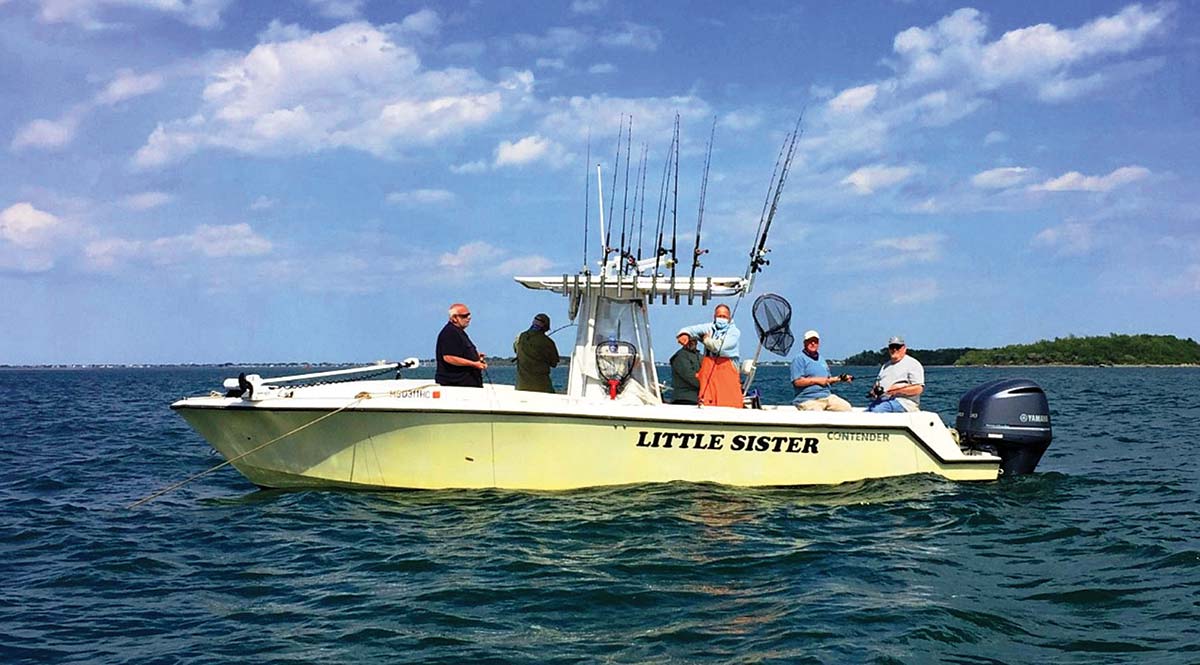
One of the most unique aspects of Capt. Jason’s charter operation when compared to the other three captains that I interviewed is that he runs a twin Yamaha F300 outboard-powered Contender 31 center console. In comparison, the other tautog operators employ single diesel downeast style hulls with a cuddy cabin to get out of the weather, featuring large and wide-aft cockpits.
Chartering a 31 Contender in cold weather creates both opportunities and challenges. On the opportunity side, Little Sister is relatively quick with excellent range and can speed from spot to spot, catching the right current flow in all the right places. The big center console also offers a lot of space at the rails fore-and-aft on either side where a half-dozen anglers can find enough elbow room to minimize tangles when bottom dropping. Yet another advantage of Capt. Jason’s 31 Contender is the ability to mount a Minn Kota electric trolling motor to “spot lock” his boat over micro pieces of prime rocky bottom that most boats that rely on anchoring will seldom fish. Plus the “electric” anchor is fairly stealthy and does not make the ruckus that a steel Danforth or Plow anchor and chain will make when it tumbles overboard and crashes into the bottom. All this noise can spook the always-wary blackfish, especially in shallow waters. On the downside, even with wing canvas and a T-Top, it’s hard to get out of the wind and weather when fishing aboard a large center console, so be sure to dress warm with multiple layers!

The extended tautog season in Massachusetts allows Capt. Jason to target tog on about 60-to-65 trips per season. He’ll do about a dozen tautog charters during the month of April, focusing on 100-foot wrecks, with the rest in the fall, where rockpiles are the prime target areas. For the spring fishery, both clams and crabs work equally well, whereas in the fall, green crabs get the nod. Anglers aboard the Little Sister use either tog jigs like the Tsunami Tog Treats, or the classic high/low sinker rig using Gamakatsu 5/0 Octopus hooks. Preferred jig colors are either white glow or green/orange, which Capt. Jason nicknames “crab guts” due to the similarities when cracking open a crab shell and allowing some of the colorful internals to spill out. Capt. Jason’s standard blackfish boat outfit is a Tsunami 701 medium action boat rod, which is combined with a Penn Fathom 15 star drag reel spooled with 50-pound PowerPro line and a 50-pound leader. For his personal use, he favors a Maxel 7-1/2-foot spin rod complemented with a Penn 4500 Slammer IV outfitted with 50-pound braid and a 50-pound mono topshot.
The Little Sister uses its “game-changing” Minn Kota Riptide Terrova electric motor to “spot lock” over the preferred structure about 70% of the time, employing the classic single anchor ground-holding technique the other 30% of the trips. As an interesting aside, he will sometimes explore other pieces of the structure when anchored by using the electric trolling motor to jog one way or another, especially when experiencing shifts in the wind and current. Capt. Jason prefers to release most of the breeding females that he catches and targets 18- to 21-inch males as the preferred eating sized fish. He advised that the males can frequently be identified by the “rusty” coloration along the side flanks of the fish. For more information on Little Sister charters, visit www.littlesister1.com.
Capt. Kerry Doughton, JB Sportfishing, Waterford, CT

J&B Tackle is no stranger to anglers who frequent the winter fishing and boat show circuit and I have spent many hours frequenting their displays at various venues and chatting it up with their knowledgeable staff. What some folks don’t realize is that the same family operation that manages the tackle shop located in Niantic, CT also runs a vibrant charter boat business located in the same locale, situated in the eastern part of Long Island Sound, NNE of Orient Point, NY. They have been taking folks fishing since 1972, when the family started fishing the local waters and beyond. Their current vessel, the “JB” is a 38 Northern Bay downeast style cabin boat that’s powered by a single inboard diesel, which allows them to fish in tough weather conditions while keeping the crew totally comfortable. I have seen Capt. Kerry doing his thing on occasion in the eastern stretches of the Sound, where I fish numerous times during the course of the season from my home port of Jamesport, NY. The JB will fish for tog seven days a week during the fall season, concentrating mostly on rocky bottom and wrecks from the mouth of the Connecticut River to Watch Hill, RI. The typical depths of his preferred bottom for togging will range from 30-to-100 feet, which requires anywhere from a 6 to a 20-ounce sinker, with the heavier lead often being required for times of the full and new moon periods.
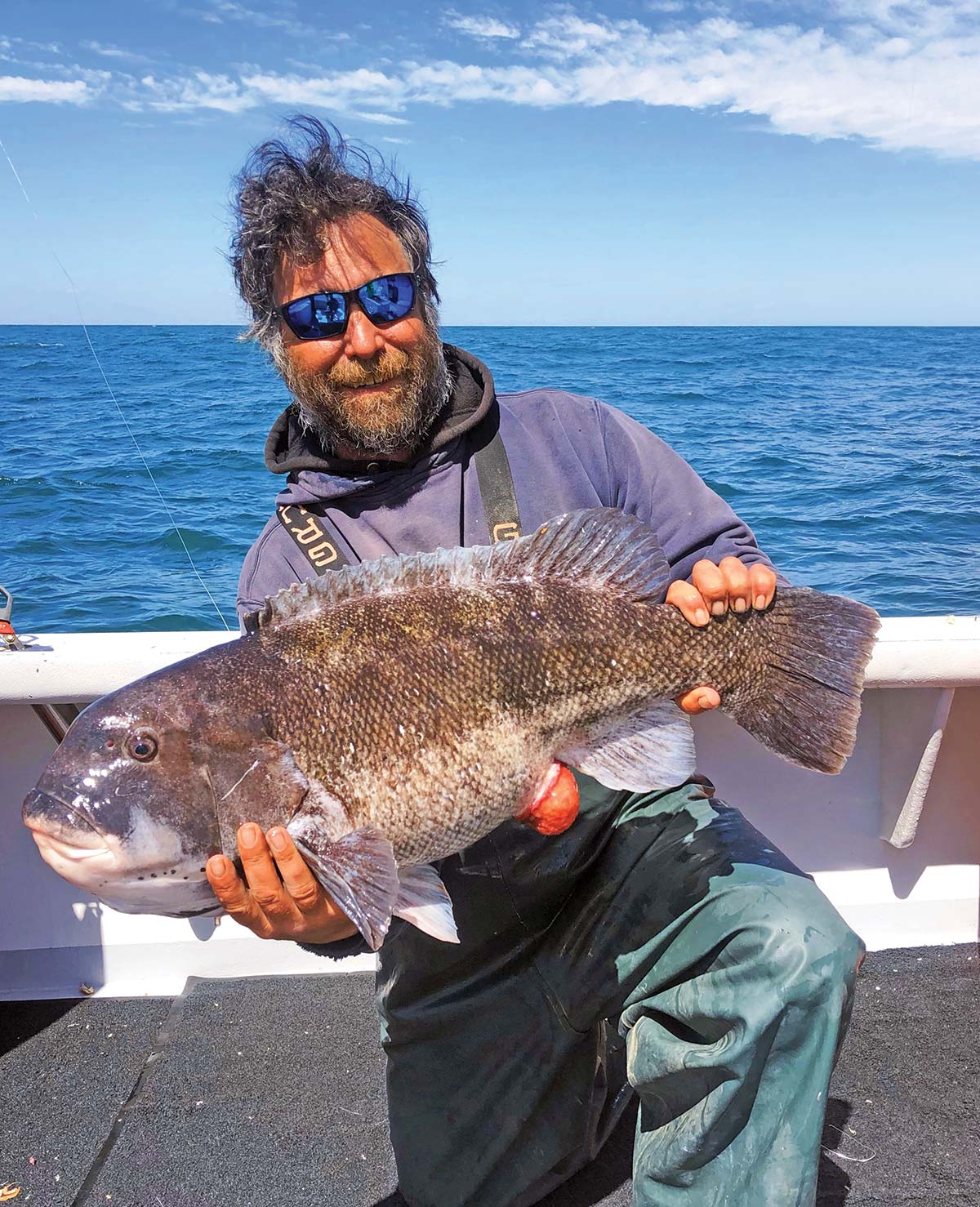
Capt. Kerry’s favorite outfit for blackfishing is a custom made seven-foot CalStar blank that’s paired with a Shimano Ocea 2000 jigging reel spooled with 40-pound PowerPro superbraid topped with a shock tippet of 50-pound mono that’s connected to the braid with a reverse Albright knot (main line wraps around the leader). The JB anchors 100% of the time when pursuing tautog and he employs a 22-pound Danforth type hook that’s connected to the bottom end of the shank with the chain connected up to the anchor eye with breakaway zip ties, just in case it gets hung up in the rocks. His #1 bait for tog are hermit crabs, but due to the frequent challenges acquiring sufficient supplies for his charter trips, green crabs are the primary backup due to their ready availability. His preferred method is to employ a modified Snafu rig, where a separate piece of a legless crab with the shell removed is cut in half and placed on each of the two hooks, versus the usual method of putting one hook in opposing sides of the same crab bait. When the current is running hard and in the same direction as the wind, he’ll tuck away into some of the quiet cove areas that dot the CT and RI coastlines to get out of the fast moving water to hold bottom with lighter sinkers. For more information on JB sportfishing charters, visit www.jbsportfishing.com.
Capt. Tom Daffin, Fishin’ Fever IV, Cape May, NJ

Capt. Tom Daffin is no stranger to catching large tautog and extremely large tautog. The former NJ State record fish, a 25.4-pounder was caught in 2015 from the decks of his boat, the Fishin’ Fever IV. This was recently surpassed by the current NJ record tog, a 25.8-pound beast that was also landed aboard his 38-foot Calvin Beal single diesel downeaster in 2020. He and his crews have bested many a 20-pound plus blackfish during their super-extended 2023 season that runs from January 1 through February 28 (four fish per person, minimum size 15 inches); April 1 through April 30 (four fish per person, minimum size 15 inches); August 1 through November 15 (one fish per person, minimum size 15 inches); and November 16 through December 31 (five fish per person, minimum size 15 inches). Accordingly, Capt. Tom books 100-plus tog trips per year, so he has a lot of experience with this species and his enviable record of nailing big fish speaks for itself. He has also produced numerous videos that are on YouTube and if you are curious about his specific encounters with large tog, you’ve got to check it out.
Capt. Tom spent a few years putting the latest iteration of the Fishin’ Fever (model IV) together and it offers a number of way-cool features that makes the job of anchoring as painless as possible. First off, he custom-designed the bow pulpit in the shape of a “T”, which neatly stows a pair of large 22-pound Danforth style anchors, with each one sporting 20 feet of half-inch chain and a basket full of half-inch line. He can work both anchor setups from the outside helm located in the starboard front corner of the 38 Calvin Beal’s spacious cockpit. He can easily let out the anchor line from this weather-protected perch and adjust each anchor rode its own individual cleat to fine-tune the bridling position of the boat over his selected wreck or reef. This allows him to cover just about every square foot of his selected tautog haven of the day.
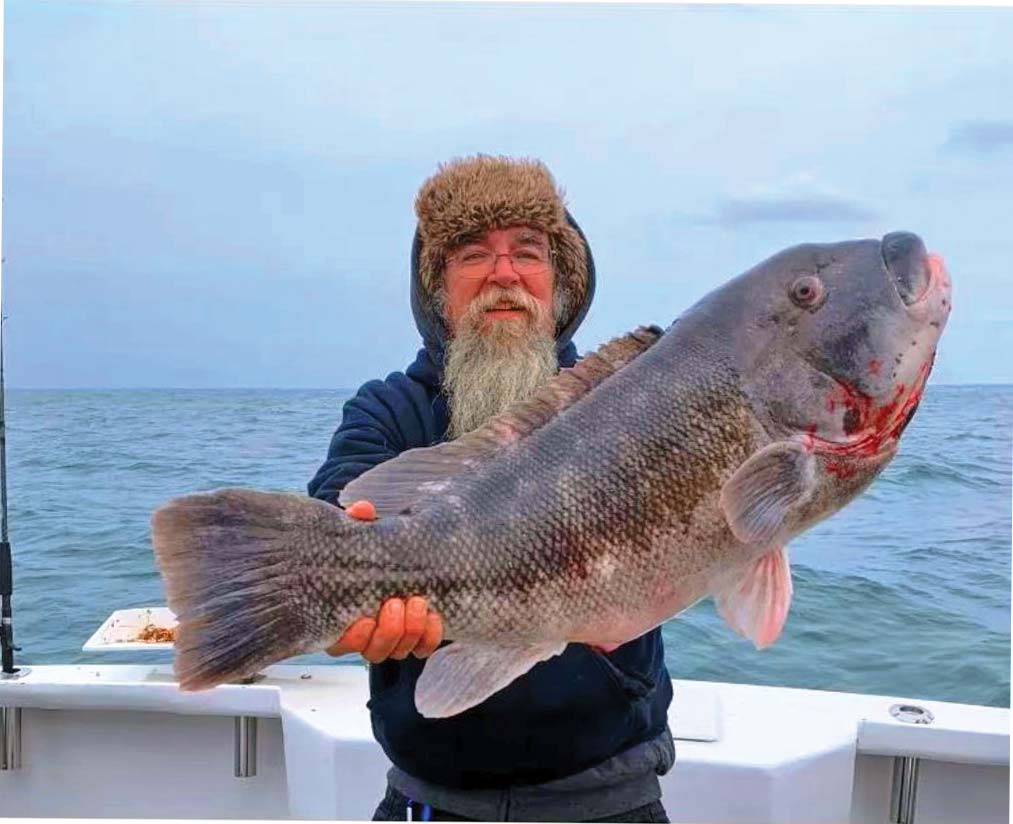
In the beginning of the year when the tog are closer to the beach, he’ll run anywhere from 8-to-17 miles off the beach to fish 50- to 90-foot depths. As the season progresses, the Fishin’ Fever IV runs 25 to 40 miles offshore to access the 100 to 150-foot wrecks. His favorite bait for bigger tog is white crabs, with green crabs a second choice based on either’s availability. Another great bait that brings in the big tog are shedder white crabs, also called leatherbacks. He uses a pair of Jigging World Z-Blade 5/0 hooks to create a Snafu rig to bridle a whole crab from either end to prevent it from spinning on the bottom. Capt. Tom prefers the shell on, which he cracks open a bit to let out a scent trail on the bottom, removing the claws and leaving the crustacean’s legs on to dangle enticingly in the current.
For his preferred rod, Capt. Tom employs a custom made 8-foot Lamiglas blank with a moderate bend, attached to a Penn Fathom 12 conventional reel spooled with either 65-pound braid with a 50-pound mono topshot, or 80-pound braid with an 80-pound mono leader. This seems like overkill with super heavy duty line, but he has caught 20-pound plus fish and pulling them out of some tight spots, and this is how he gets it done. He likes the longer rod for its ability to rock like a seesaw in choppy seas, with enough length to keep the bait as still as possible on the bottom to fool even the most wary fish. His standard boat rods are Jigging World Black Demon sticks that are 7-1/2 feet long and rated for 30-50-pound line. These will also be equipped with the aforementioned Penn Fathom 12 reels. Capt. Tom is south Jersey’s big tog guru and with the Garden State’s extended season, he gets a lot of traffic from anglers coming down the Jersey Turnpike from up north. In his experience, the tog seem to feed most aggressively when the surface water temps are anywhere from 44-to-50 degrees. For more information, visit www.capemaycharter.com.
Capt. Phil Kess, Fishy Business, Orient, NY
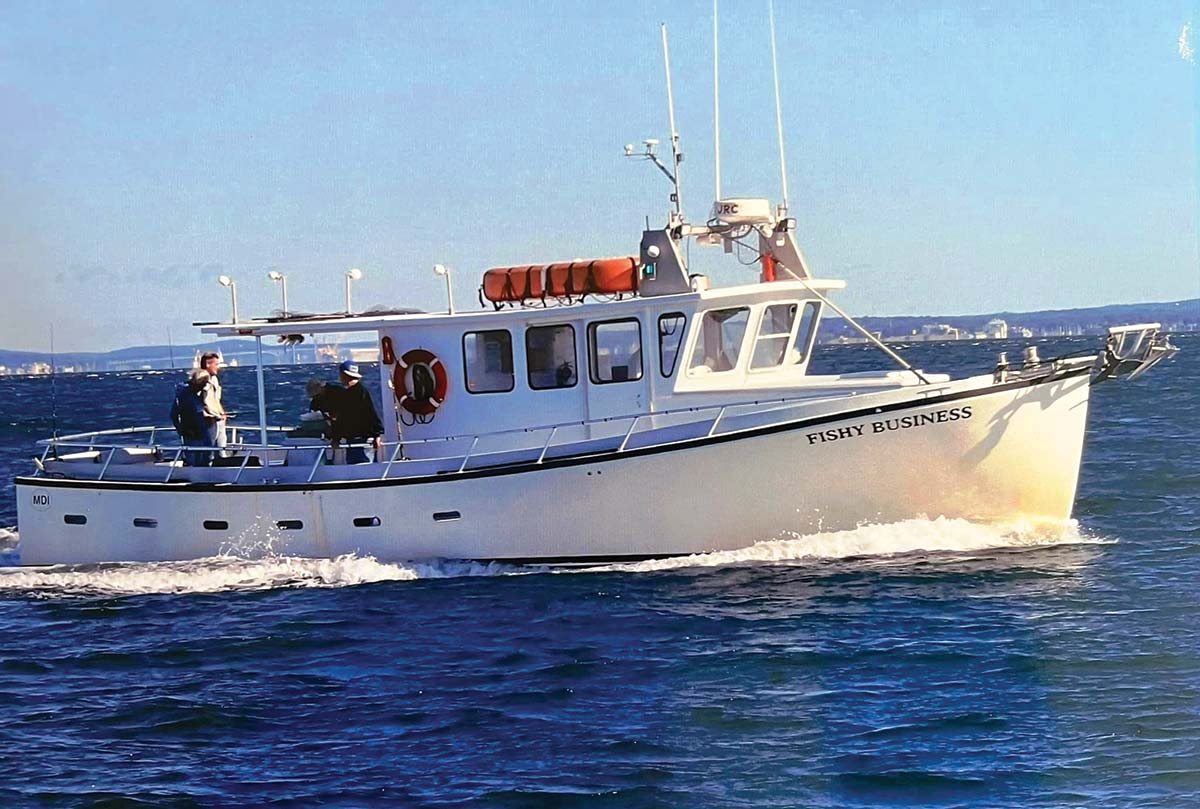
Out of the fab four tog captains that we are covering in this article, Capt. Phil Kess is unique in that he runs a party/head boat operation out of Orient, NY. His vessel is a Maine-built, single diesel 45 MDI and features a center cabin that allows the crew to comfortably shelter out of the weather when underway. The T-shaped bow pulpit allows Capt. Phil to work two anchors to position the Fishy Business precisely over the rocky bottom and wrecks of the eastern Long Island Sound. Even with New York’s somewhat truncated blackfish season, he still does 50-plus dedicated tog trips each year. With GPS and Spot-Lock, many weekend warriors are hogging the known wrecks in the eastern sound and they get fished out fast. Accordingly, Capt. Phil prefers the myriad rocky bottoms and seamounts that dominate the area and in the beginning of the fall season, will fish water as shallow as 10 to 30 feet to put his anglers into the mix. As the season progresses and the water gets colder, he will focus more on rocky areas in the 50- to 90-foot depths. The water currents in the eastern sound areas can make it very difficult to fish, especially if the wind and current are moving in the same direction and are influenced by either a full or new moon. There are times where you can’t effectively hold bottom even with a 20-ounce sinker!
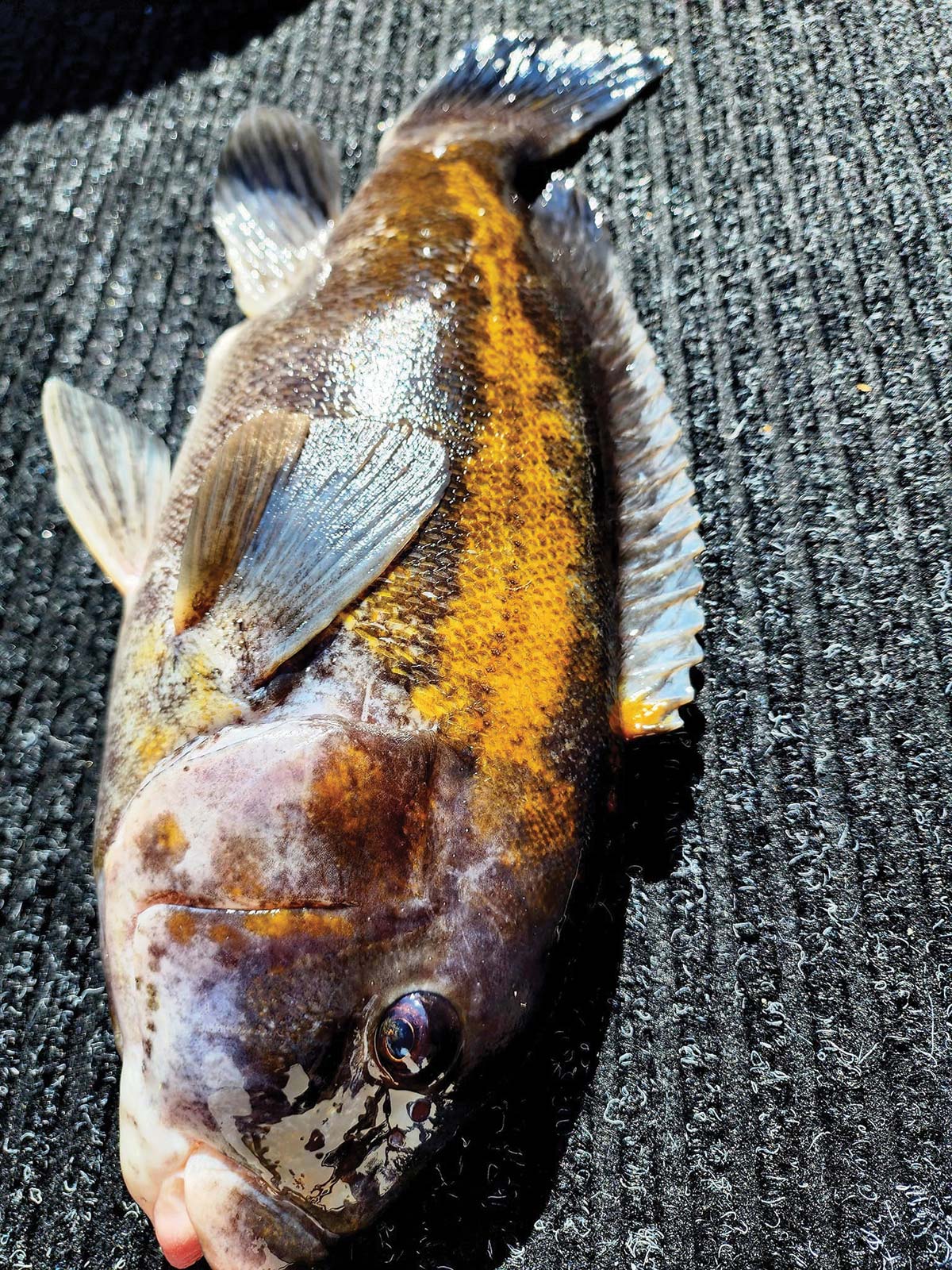
Capt Phil’s go-to baits are green crabs, white crabs and hermit crabs in that order. It’s all based on availability and the greenies seem to dominate the bait supply shops, so they get the first call. For his personal rod, Capt. Phil prefers a medium action, 6-1/2-foot CalStar custom rod, paired with an old-school Penn 2/0 Senator reel with a slow 2:1 retrieve ratio. He feels that the lower gear ratio gives this outfit more leverage to pull the tautog out of a wreck or rockpile before they know they are hooked and dive back into the structure to hang it up and break off. When togging, it’s the first 10 feet of the fight that makes or breaks the catch effort! For boat rods, the Fishy Business is equipped with Penn Fathom 15 outfits spooled with 50-pound SpiderWire or Daiwa J-Braid, which is tied directly to a swivel with no topshot. Capt. Phil likes the “Montauk Rig”, which features a plaited knot loop where the hooks are situated below the sinker loop, which is tied amidships on a short length of 60-pound mono with two 5/0 Octopus hooks attached to the bitter end via a modified Snafu slider rig. The opposite end is then tied to the swivel to complete the connection.
I see the Fishy Business out on the water on occasion during my forays into the eastern Sound and his folks always seem to have smiles on their faces and catch a lot of fish. For more information, visit www.fishybusinesscharters.com.




